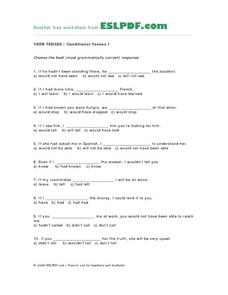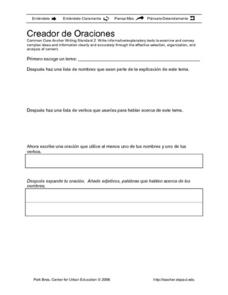Curated OER
The Present Subjunctive: When?
Some Spanish learners believe the subjunctive is frightening. Help eradicate that fear by going into depth on when to use the present subjunctive. There are many different situations in which the subjunctive is used described here. You...
Curated OER
5 Question Review- Tener
Tener, the Spanish word meaning to have, is an essential vocabulary word for beginning Spanish speakers. Provide them with these five questions to assess their understanding of the verb in context. Consider having them translate each...
Curated OER
Direct, Indirect, and Reflexive Pronouns
Provided here is a thorough review of direct, indirect, and reflexive pronouns. First learners study the chart for direct object pronouns, reading through the Spanish and English equivalencies. Then, they read the bulleted information...
Curated OER
An Oral Course for Students of Spanish
Students practice new Spanish vocabulary and participating in a dialogue with another student. In groups, they use the internet to pretend to buy an airplane ticket and make hotel reservations on a trip to a Spanish-speaking country. ...
Curated OER
Verb Sheet
Students complete template on the conjugation of any tense of verbs in Spanish, and then write teacher-dictated sentences using these verbs.
Curated OER
Preterite Forms of -AR, -ER, -IR Verbs
Students explore how to form the preterite forms of regular -AR, -ER, and -IR verbs. They complete a variety of written task in which they write the correct preterite forms of the verbs. Students complete a worksheet finding the correct...
Curated OER
Seem & Look like
In this grammar worksheet, students choose the appropriate helping verb, seem or look like, to complete ten sentences grammatically correct.
Curated OER
Verb Tenses; Conditional Tenses-1
In this foreign language worksheet, students read 10 sentences with missing words. Below each sentence are three verb choices. Students select the best choice to complete each sentence.
Curated OER
Verb Tense for Regular and Irregular Verbs
In this regular and irregular verb tenses activity, 6th graders write the present, simple past and present perfect form of regular and irregular verbs; the instructions are in French.
Curated OER
Using Am, Is, and Are and Find the Verbs in a Paragraph
In this pronoun and verb worksheet, student read a story about a student named Marie. They answer 5 questions about the passage using am, is, and are. They circle the verbs in the reading selection.
Curated OER
Future Actions
How do you conjugate a reflexive verb? This plan suggests reading a children's book to your intermediate Spanish speakers. Follow the reading with a PowerPoint slide show that presents reflexive verbs, a sentence using the verb, and a...
Curated OER
Maggie's Adventures Grades 1-2
Students use Maggie's Learning Adventures online activity. They play a matching or memory game to become aware of homophones. Students recognize that there two ways to use many words. They practice with noun or verb identification by...
Curated OER
¿Qué hora es?
Use this resource to quiz your language learners on telling time. Two exercises are provided; the first one asks quiz takers to use the digital time to write out the time in Spanish. The second exercise is the exact opposite: learners...
Curated OER
The Gender of Nouns
Yes, a puzzle! Kids of all ages love completing puzzles, even if they're linked to work. This grid focuses on the definite articles el, la, los, or las. For each of about 40 nouns listed, pupils must find the appropriate square and shade...
Curated OER
The Personal a-Explanation and Practice
What is the personal a? It's a tricky concept to Spanish language learners, but this worksheet makes it simple. Examples and an explanation precede a short practice exercise. A great way to introduce your learners to the topic, but...
Curated OER
Object Pronouns with Commands
Intermediate and advanced Spanish language learners will appreciate knowing how to shorten their sentences when making commands. After all, native language speakers usually use informal language when conversing with other native...
Curated OER
Some Adverbs from Feminine Adjectives Grow
Looking for a clear explanation of Spanish adverbs? Here it is! There's a set of seven bullet points that gives the rules, and there is a short practice activity at the end.
Curated OER
Subjunctive in Noun Clauses
The subjunctive is used to express a wish, desire, or doubt. How is it used in noun clauses? This worksheet gives an example of the subjunctive in a noun clause and explains the parts of the sentence. After reviewing the information, see...
Curated OER
Tu o Usted? Explanation and Worksheet 1
What is the difference between using tú or usted? This worksheet provides a thorough, clear explanation, and there's an opportunity to practice. The exercise lists different people and asks the learner to identify whether...
Curated OER
Creador de Oraciones
Start by selecting a topic. What do you want your class to learn more about? Then, distribute this helpful note-taking guide. They record their topic, a list of names that could be associated with it, a list of verbs that come up when...
Curated OER
Preterite vs. Imperfect #8
When do you use the preterite tense, and when do you use the imperfect? They're commonly confused, so give your class lots of practice opportunities to drill the difference into their memory! This short exercise would be a great...
Curated OER
Ir + a + infinitive soup
Yum, alphabet soup! Learners are presented with a bowl of alphabet soup containing some Spanish words. Combine these words with the ir+a+infinitive structure to complete the 12 sentences provided. A fun twist on basic conjugation!
Curated OER
Review of Adjectives
The easiest way to learn how to use adjectives is through practice, practice, practice! Print out pictures of people and various objects, and have pairs attempt to describe the items together. This plan suggests providing laminated index...
Curated OER
Las Caras (The Faces)
First graders create masks. They practice using Spanish words to describe facial expressions and their individual masks. They review the verb"tener," to show characteristics than can be expressed on a mask: "tengo calor" or "Tengo miedo."























